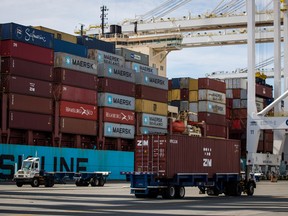Congestion at inland rail yards and warehouses in Toronto and Montreal an ongoing problem

Article content
Transportation of freight by rail from Canada’s West Coast ports to the country’s major urban centres continues to experience significant delays, with boxes piling up fast at the Vancouver and Prince Rupert, B.C., ports.
Advertisement 2
Article content
Global shipping giant Maersk A/S warned customers for the third time recently that due to significant congestion in Toronto, Canadian National Railway Co. (CN) is metering, or regulating, the flow of Toronto-bound releases from Prince Rupert, B.C., to ensure they do not gridlock its facilities. Canadian Pacific Railway Ltd.’s (CP) dwell times — the time it takes for boxes to be taken away by rail after being unloaded from a ship — are higher than normal due to yard capacity.
Yard utilization at Vancouver’s Centerm terminal is currently more than 97 per cent, while port managers consider terminals to be at maximum capacity when utilization is at 80 per cent.
“To combat the Toronto congestion on terminal and ensure vessels are not delayed, operations is utilizing an off-site yard near the terminal for all new incoming Toronto containers,” Maersk said in a note to customers using the Prince Rupert port.
Advertisement 3
Article content
Congestion at inland rail yards and warehouses in Toronto and Montreal has largely been attributed to insufficient drayage capacity — industry terminology for making short hauls from ports or other areas to nearby locations — and is an ongoing problem due to a shortage of qualified truck drivers.
The Vancouver Fraser Port Authority (VFPA) said that all four of its container facilities had dwell times of more than seven days, compared to a monthly average of five days from May 2021 to June 2022. Dwell times for the rail carriers were also above average, with both CN and CP reporting more than seven days for the Centerm facility and CP reporting seven days at the port’s other three facilities – Vanterm, Deltaport, and FSD.
Advertisement 4
Article content
CP works closely with Vancouver terminal operators to maximize capacity, spokesperson Andrew Cummings said in an email. While their platforms are at record highs, CP is committed to urgently reducing any backlog, Cummings said.
The railway is currently managing heavy customer volumes at inland terminals and operations are fluid. To maintain overall network efficiency, Cummings added that “all participants in the supply chain must work together to pick up and return equipment promptly.”
-

CN, union spar over impact of strike on Canada’s largest railroad
-

CN Railway, union still at loggerheads as strike enters third day
-

CN Railway braces for surge in grain shipments as optimism grows for harvest
CN spokesperson Jonathan Abecassis said in an email that the situation is “largely” due to a lack of warehouse and trucking capacity in Toronto. CN has been working to secure more storage space outside its own yards in Toronto, while also increasing the number of Toronto-bound trains from the West Coast to reduce congestion at Vancouver and Prince Rupert, Abecassis said.
Advertisement 5
Article content
The Container Port Performance Index (CPPI) 2021, developed by the World Bank and S&P Global Market Intelligence, placed the Port of Vancouver near the bottom of the container cargo efficiency rankings for the world’s largest containerized cargo ports Only Long Beach, Calif., and Los Angeles ranked worse at 369 and 370, respectively. The Port of Prince Rupert landed at 344, ahead of Tacoma, Wash., (345), but behind Seattle (336)
VFPA said in an email that supply challenges at the ports over the past two years were the result of the COVID-19 pandemic and high cargo volumes from Asia, and were further exacerbated in 2021 by extreme weather events in B.C.
But the port authority said its multi-faceted approach will help address ongoing supply chain challenges. In partnership with container terminal operator DP World, the port is leading the Centerm Expansion Project and South Shore Access Project to help meet increasing demand for containers shipped through the Port of Vancouver, while $1 billion will be invested in road and rail infrastructure to remove bottlenecks and increase capacity so that supply chains can manage future trade growth.
rshelton@financialpost.com


